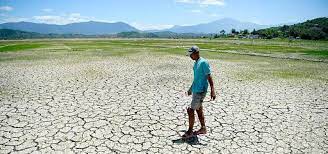Italy: Hottest year since 1800 leaves mark on agriculture

Milan: There is now some relief after a water crisis that hit Italy during the last year: Rain has started to fall. But, is it enough?
Rainfall in 2022 was more than 30% below the average. It was a scorching year that broke all heat records since 1800, according to the National Research Center of Italy.
The temperature increase was almost 1 degree Celsius (33.8 degrees Fahrenheit) higher than the calculated average over the 30 years of 1990-2020, Italy’s largest public research institution has said.
There has been little snow on the mountains to act as a reservoir for the summer and little water falling from the sky in other seasons, even in the early part of the current fall season.
So much so that the main lakes and rivers in northern Italy are flowing well below usual levels.
This is the case in Lake Garda which is 35.7% full, Lake Maggiore – filled at 35%, and Lake Como – 48.2% full, according to the Consortium Enti Regolatori dei Grandi Laghi, an official body that collects data on the water filling.

Not to mention the water crisis affecting the Po, Italy’s main river artery that crosses the country from west to east for more than 600 kilometers (373 miles), and the Po Valley that feeds 30% of national agricultural production.
It is a bountiful food valley where wheat for pasta, cheeses such as Parmigiano Reggiano, cured meats such as Prosciutto di Parma or Culatello di Zibello, and fruit and vegetables are produced.
Agriculture is the productive sector that has suffered the most from the situation.
“We have left behind a very complicated year characterized by nine months of no rainfall and water resources up to 70% below the annual average. A problematic year that resulted in production losses in the order of 50%,” said Umberto Bertolasi, director of Coldiretti -Milano, Monza-Brianza and Lodi, the biggest Italian organization of farmers.
He estimates there has been €2 billion ($2 million) loss in the Lombardy region alone, and at least three times that nationally.
“We are submitting requests for recognition of a natural disaster to the state,” he said in an interview. “Crops that have suffered most are rice and maize. In some cases, it was not possible to harvest anything, and even when we managed to irrigate, there were unexpected yield reductions of 30% due to high temperatures and incomplete cob development.”
It is a situation that Antonio Dornetti, who grows cereals, maize, and fodder for livestock and raises dairy cows on the outskirts of Milan, knows well.
“This year we have lost a lot: 40% to 60% on both maize and forage from the meadows. We hope for more rain next winter, but if it continues to rain so little, it will be even worse,” he told Anadolu Agency after he cut one of his green meadows. A cut, which was supposed to be the sixth of the season, is only the third of the year instead due to the drought.
At Ponte della Becca, where the Ticino River, has its source in Switzerland and crosses Lake Maggiore, meeting the Po, the level is 3 meters (10 feet) below normal.
It is impressive in November to walk across the sand before reaching the water. New islands have formed, which nature seems to have taken possession of, with trees tall and lush.
The days of the November 2014 flood, which caused the river to overflow in several places seem far away. But the concern for farmers and breeders is about the near future.
“The current situation does not leave us calm. There was a lack of rainfall in October and we have already had problems with some autumn sowings. For the coming season, we have to build on the experience of this past year with pre-planned solutions. Although the hope is that, we will no longer be on red alert,” said Bertolasi.
The farmers who have not seen the state compensation arrive yet, are even more worried and are suffering from the disproportionate increase in production costs, according to Coldiretti.
“No aid has arrived yet from the state. A pity at a time when production prices have risen so much” added Dornetti.
Increases in costs which, according to Coldiretti, range from 129% to 170% for diesel, are three times more for fertilizers.





